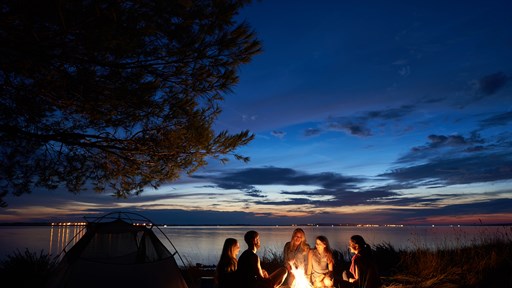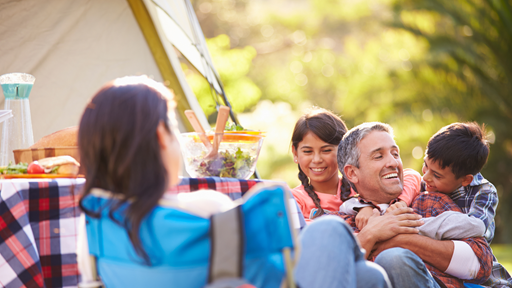Just because the temps are falling does not mean that it is time to give up on camping. With more and more KOA campgrounds choosing to be open no matter the time of year in all parts of the US, camping in the late fall and early winter is actually a lot of fun. But to make sure that you stay safe, it is important to take certain precautions—like checking your car to make sure that the antifreeze levels are right and that your lights in working properly. And it’s also important to add a few things to your trunk or RV, just in case you run into cold weather delays.
Here are seven things you should never leave home without during the winter
1. Extra Clothes
Having an extra coat or sweatshirt, warm socks, a hat and gloves can make a big difference if you end up out in the cold. Make sure to carry them for each member of your family, and put them in a place where they are easy to get to.
2. Snacks
Even if you have a hard and fast rule about not eating in your vehicle, you need to relax a little when it comes to emergency supplies. Individually wrapped energy bars, packs of trail mix, dried fruit and jerky are all easy to transport, have a decent shelf life and will give you the energy needed to keep you going—and toss in a few extra bottles of water, too. Do pets travel with you? Do not forget food and water for them as well.
3. Blankets
Emergency blankets made of foil Mylar are inexpensive and take little room, but are exceptional at reflecting body heat. They are available at most sporting goods stores and online, and cost as little as a dollar.
4. Booster Cables
Extreme weather can kill batteries. That’s why it’s important to carry a set of cables with you. And if you have never had to jump start a vehicle before, learn how to safely use your cables before you head out on the road. A friend, family member or trusted mechanic will be more than happy to help.
5. Emergency Flares and Distress Flags
If you do end up on the side of the road, it’s important for other drivers to be able to see you. Emergency flares and distress flags are a great way to ensure you and your car are visible to other drivers and emergency personnel.
Additionally, having an emergency flare on hand can be beneficial in starting a fire for heat in an emergency. If you need to walk along the road to find assistance, you can carry your distress flag with you to make you more visible to drivers.
6. Flashlight and Batteries
Packing a flashlight and extra batteries is essential for any winter survival kit. You can use your flashlight to see under the hood, change a tire and signal for assistance when it is dark outside. You can also use your flashlight inside your vehicle to help you see while you eat or perform other tasks.
When selecting a flashlight, choose an option that can withstand constant use and harsh handling — you do not want a flashlight that can break if you accidentally kick it or it falls to the ground. It is also essential to have plenty of compatible batteries on hand to prevent the risk of your flashlight losing power when you need it most.
7. Emergency Food Rations and Bottled Water
If you plan on driving in a rural or secluded area, you may find yourself stranded for several days. Investing in emergency food rations allows you to stay hydrated and nourished as you wait for help to arrive.
When choosing food rations, you should select shelf-stable items such as canned food and calorie-dense products like granola bars. Since you will likely not have access to propane or other fuel, you want to focus on packing food you do not have to heat before eating. Even if you manage to create a fire, your surroundings may contain wet wood, making it difficult to heat any food you bring.
Many travelers leave water out of their winter kits because they do not feel thirsty when they are cold. However, staying hydrated helps your body regulate its temperature and stay comfortable and alert as you wait for help to arrive. If you are traveling to or through a remote area, you should plan to bring extra water since you may need to wait for assistance for a longer time.
While snow may be readily available, this does not mean you should melt and drink it. Snow often contains many pollutants and is not safe to consume. You may also have difficulty melting the snow without a heat source. By packing food and water beforehand, you and your passengers will stay nourished and hydrated if a winter accident occurs.
Other suggestions? Consider adding in a camping shovel, and or kitty litter (for traction on ice), tire chains and a tow chain or rope. And remember, if you travel with children, make sure you have extra baby food, diapers and wipes for the littlest campers, as well as books and games to help older kids pass the time.
Experience Winter Camping at KOA
Winter camping is a great way to see nature differently and participate in new activities such as skiing, snowshoeing and ice fishing. As you travel to your destination, however, it is essential to ensure you have the supplies you need in case the roads suddenly become unsafe or you have car trouble.
If you want to experience the many joys of winter camping, KOA has you covered thanks to numerous locations with year-round availability. Find a location near you today for a great way to enjoy the great outdoors, even in the colder months.
About the Author: Kampgrounds of America
Kampgrounds of America is the largest system of open-to-the-public campgrounds in the world, with over 500 locations across the United States and Canada. Founded in Billings, MT in 1962, KOA’s family of campground brands – KOA Journey, KOA Holiday and KOA Resort – today serve more than a million camping families each year. KOA is dedicated to “connecting people to the outdoors and each other” by providing people with a variety of camping experiences and the information they need to make the most of their camping trip. Read more of their camping and travel resources by visiting KOA.com/blog.

























